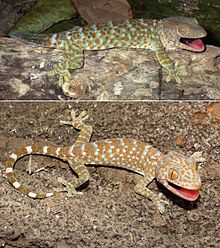Tokeh
| Tokeh | ||||||||||||
|---|---|---|---|---|---|---|---|---|---|---|---|---|

A tokeh in East Timor |
||||||||||||
| Systematics | ||||||||||||
|
||||||||||||
| Scientific name | ||||||||||||
| Gekko gecko | ||||||||||||
| ( Linnaeus , 1758) |
The Tokeh or Tokee ( Gekko gecko ) is a nocturnal Gecko and reaches a length of up to 35 centimeters. The tokeh was first described as early as 1758, then still as Lacerta gecko . It is the type species of the genus Gekko , whose representatives are also known as real geckos. It is named after the sound of the male animal's calls: .
features
The tokeh is blue-gray to brown-gray in color and patterned with numerous red and blue spots. Young animals have a dark blue, white banded tail. The scales are grainy. Rows of larger hump scales stand between the smaller scales. The head is broad and covered with small, polygonal scales. Males differ from females by having a larger head and 10 to 24 preanal pores arranged in an angular row. In addition, the root of the tail is thickened because of the hemipenic pockets inside .
distribution
The tokeh lives from northeast India via Bangladesh , southern China , Taiwan , Southeast Asia and the Malay Archipelago to the Aru Islands in the west and the Philippines in the north. It was introduced by humans in Florida , Hawaii and Martinique . The lizards originally lived in the rainforest, but today they also live as cultural followers on or in houses. In their homeland, tokehs are considered lucky charms and therefore enjoy a certain protection.
Reproduction
Like almost all geckos, the tokeh always lays two hard-shell eggs per clutch. However, a female can lay eggs up to five times a year. The eggs stick to the ground and are also glued together. The female stays with her clutch and defends it against predators. The young geckos hatch after 100 to 180 days, depending on the temperature, and are then eight to ten centimeters long. They are guarded by the female until they lose their youthful coloring. Tokehs can live to be 25 years old.
Way of life
Tokehs belong to the group of lamellar geckos, each foot is covered with a billion fine hairs (about 200 nanometers wide and long), so-called spatulae . Due to Van der Waals forces , they find a hold on all surfaces and can even walk upside down on panes.
The tokeh feeds on large insects (such as crickets, grasshoppers, cockroaches, etc.), but also on mice and smaller reptiles. It is generally said that the tokeh will eat anything it can overwhelm. He usually takes in drinking water through food or by licking drops of water. In captivity, water uptake from the vessels provided was also observed.
literature
- Ingo Kober: Tokehs in the terrarium: better than their reputation. In: Reptilia. Vol. 7, No. 4 = No. 36, 2002, ISSN 1431-8997 , pp. 43-49.
- Wolfgang Grossmann: The Tokeh. Gekko gecko. Natur-und-Tier-Verlag, Münster 2004, ISBN 3-937285-31-8 .
- Wolfgang Grossmann: From Tokeh. In: Terraria. Vol. 3, No. 3 = No. 11, 2008, ISSN 1613-1398 , pp. 24-30.
- H. Rösler: Studies at Tokeh: 2. Intraspecific variation of the Southeast Asian populations of Gekko gecko (Linnaeus, 1758). In: Gekkota. Vol. 5, 2005, ZDB -ID 2080442-8 , pp. 65-149.
- Manfred Rogner : Lizards. Distribution, maintenance, breeding. 2nd, updated and expanded edition. Ulmer, Stuttgart 2005, ISBN 3-8001-4380-1 .
Individual evidence
- ↑ Gekko gecko in The Reptile Database ; Retrieved January 22, 2011.
- ↑ Max Planck Society: Hairy feet stick better to a damp blanket. November 8, 2005, accessed November 23, 2014.

